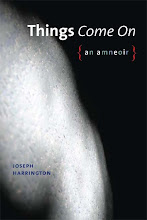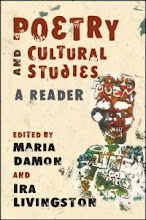I’ve been meaning for some time to write something about Rachel Zolf’s book Masque (Mercury Press 2004), and now she’s come out with another one, Neighbour Procedure (Coach House 2010). The first is a “masked” memoir in the form of verse dialogue. The second deals with the Palestinian-Israeli conflict; it was occasioned by a trip to “Israel-Palestine” and contains “some of the journey’s mad affects.”
Masque is large – 10x8” pages – and the verse is spread out over the pages. It is “spoken” by various characters – The Media Man (who is also The Father, the egomaniacal reporter/TV personality, Benny Z-d); The Daughter; The Philosopher (who is mostly Marshall McLuhan); The Censor (who “redacts” certain words); The Whisper (which says things like “you fucking screaming idiot”), and so on. At first some of the voices occur on separate pages, then in consecutive dialogue. But finally, they mostly are all talking at the same time, by way of interlined stanzas; the names in the right and left margins alert the reader to the first line of the character’s speech, but the parts are written in alternating lines. Sometimes there are just a few short lines crouching in the upper left-hand corner of the page; sometimes there is one column of text that is left-justified, one that is right-justified, and one coming down the center. There are even drawings and extended etymologies. I’m not going to try to reproduce this method on Blogger. Suffice it to say that Zolf depicts a very complex set of relationships within and beyond a family in a few (colloquial) words. Much of the material is taken from Canadian Broadcasting Corporation footage, as well as newspapers which her father – who just happens to be a Media Man, too – wrote for.
Neighbour Procedure is rather different. The title refers to the practice by the Israeli army of using residents of Palestinian neighborhoods as de facto human shields. Again, much of the material comes from “found” sources: newscasts, web sites, commercials, the Qur’an, Judith Butler, etc. The first section reminds me of the ghazal form – that is, the juxtaposing of lines of verse that do not follow one from the other, but which have a lot to do with each other. (In this respect, it reminds me of Susan Tichy’s Gallowglass, except that there it is the American-Iraqui conflict that is the source). Other poems are lists of numbers and names, or a mosaic of the words “car [mule, belt, bike] bomb” with musical notations added. The middle section is composed of white-out poems from Ibn Barun’s 11th c. “Book of Comparisons” of Arabic and Hebrew words, as a method of glossing the Torah (mixed in with the poet-speaker’s own stutterings). The rest are various mash-ups and docupoems – one section is composed of “word maps.” And the notes at the end are well worth reading.
The barber
One soldier danced into the shop, 'Nice, nice'
Whose faces were painted certain images don't appear
Cutting in random lines the machine touched my scalp
Can you be gentle I'm not an expert open your mouth
A group of children stones his weapon on my shoulder
Intolerable eruption patting his chest, 'Now I'll tell you my name'
Sometimes staccato sometimes continuous
The soldier left the barbershop with the scissors
The soldier left the hair on my lips
from Startles
-
Startles
Upside down tee shirts hang on the line under an overhang, dripping from
the head space below. Half moon on white shirt or window whose tra...
2 days ago











No comments:
Post a Comment